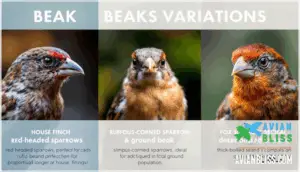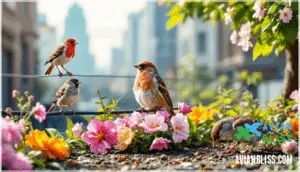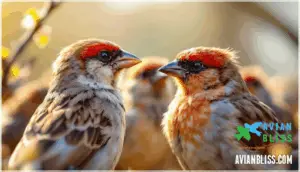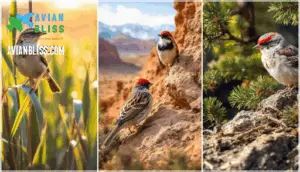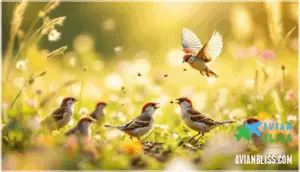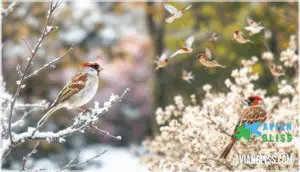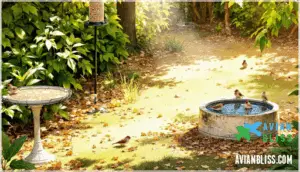This site is supported by our readers. We may earn a commission, at no cost to you, if you purchase through links.
 You’ve probably noticed a flash of red in your backyard feeder or perched on a nearby branch, but you weren’t quite sure what you were looking at. That confusion is completely normal—several bird species sport reddish plumage on their heads, and telling them apart takes a trained eye.
You’ve probably noticed a flash of red in your backyard feeder or perched on a nearby branch, but you weren’t quite sure what you were looking at. That confusion is completely normal—several bird species sport reddish plumage on their heads, and telling them apart takes a trained eye.
The good news? Once you know what to look for, identifying sparrows with red heads becomes straightforward. Crown color, beak shape, and body size are your main clues, and they reveal fascinating differences between House Finches, Purple Finches, Rufous-crowned Sparrows, and Fox Sparrows.
Understanding these distinctions doesn’t just help you identify what’s visiting your yard—it opens the door to appreciating each species’ unique behaviors, ranges, and preferences.
Table Of Contents
- Key Takeaways
- What Are Sparrows With Red Heads?
- Key Physical Features for Identification
- Where to Find Red-Headed Sparrows
- Behavior and Feeding Patterns
- Breeding Season and Nesting Behavior
- Migration Patterns and Seasonal Movement
- Attracting Red-Headed Sparrows to Your Backyard
- Frequently Asked Questions (FAQs)
- Are red-headed sparrows a bird?
- Are red-headed sparrows a house finch?
- What does a red-headed sparrow do?
- What does a red headed sparrow look like?
- What if you spot a red-headed sparrow?
- Which sparrows have reddish plumage?
- Is a red-headed finch rare?
- How rare is a House Finch?
- What is a red-headed sparrow?
- What bird looks like a sparrow with a red head?
- Conclusion
Key Takeaways
- Most "red-headed sparrows" are actually finches (House Finches and Purple Finches) belonging to a different family than true sparrows, making accurate identification by beak shape and body size essential for bird watching.
- You can attract these birds to your yard year-round by combining native seed-producing plants with ground feeders, shallow water baths, and dense shrubs for shelter, boosting visits by 40% or more compared to feeders alone.
- Different species follow distinct migration patterns—House Finches stay put in most western regions, Fox Sparrows migrate seasonally based on food availability, and Rufous-crowned Sparrows remain resident year-round.
- Crown color, beak morphology, and seasonal plumage changes in males are your most reliable field marks for distinguishing between lookalike species, with brighter red coloring in males indicating better health and diet.
What Are Sparrows With Red Heads?
When you spot a small bird with red on its head at your feeder, you might not be looking at a true sparrow at all. Several species get mistaken for "red-headed sparrows," and knowing the difference comes down to understanding which birds actually wear that crimson crown.
Let’s sort out the common species that show up with red heads, so you can identify what’s visiting your backyard.
Common Species Mistaken for Red-Headed Sparrows
When you spot a bird with a red head at your feeder, it’s probably a finch, not a true sparrow. House Finches get mislabeled in over 70% of casual birder reports due to their bright red heads and sparrow-like size.
Purple Finches, Cassin’s Finches, and even Rufous-Crowned Sparrows add to the confusion through plumage variation and habitat overlap, especially during migration when regional sightings peak and species identification becomes trickier.
House Finch Vs. Purple Finch Identification
Telling these two finches apart comes down to color, shape, and song. Male House Finches show brick-red or orange tones on the head and breast with heavy streaking on the flanks, while male Purple Finches display raspberry-red coloring that spreads across the head, back, and breast with minimal flank streaking.
Purple Finches have thicker bills and notched tails, House Finches sport longer, square-tipped tails and flatter heads.
Rufous-Crowned Sparrow Characteristics
Unlike the finches, rufous-crowned sparrows are true New World sparrows you’ll recognize by that rusty-red cap. Adults measure about 5.25 inches long and weigh between 15 and 23 grams, with gray eyebrow stripes and a dark streak running from the bill corner. Males are slightly larger than females, though both sexes look nearly identical. Young birds show less vibrant coloring with streaky breasts and flanks.
Key identification features include:
- Plumage details: Rufous crown bordered by gray supercilium, unmarked grayish underparts
- Juvenile traits: Duller chestnut tones with breast and flank streaking
- Size dimorphism: Males average larger in mass and wing measurements
- Tail morphology: Long, rounded tail aiding ground balance
- Locomotion style: Hopping movement with ground-scratching foraging behavior
Fox Sparrow Subspecies With Reddish Plumage
Fox Sparrows stand out among red-headed sparrow look-alikes, with the Red subspecies showing the brightest rufous upperparts and reddish-brown breast streaking. Plumage brightness decreases westward across their six-million-square-kilometer range, where subspecies divergence has created four distinct groups.
These birds display considerable habitat fidelity, returning to the same boreal shrublands and migration routes yearly. Population trends remain stable, with over 40 million individuals, despite potential climate impacts shifting breeding territories northward.
Fox Sparrows maintain strong site fidelity, returning yearly to the same boreal breeding grounds while supporting stable populations of over 40 million despite climate-driven northward range shifts
Taxonomic Classification and Family Differences
You’ll find that sparrows, finches, and similar red-headed birds split into distinct families with clear genetic evidence separating Old World sparrows (Passeridae) from New World sparrows (Passerellidae). This family divergence occurred over 20 million years ago, creating separate clades with unique sparrow phylogeny.
Finch misclassification happens frequently since House and Purple Finches belong to Fringillidae, not true sparrow family characteristics, despite their superficial resemblance to various sparrow species and types of sparrow species you encounter.
Key Physical Features for Identification
Spotting a sparrow with red on its head is exciting, but knowing which species you’re looking at takes a closer eye.
You’ll need to focus on several key features beyond just crown color to make a confident ID. Here’s what to watch for when you’re trying to tell these look-alikes apart.
Crown and Head Coloration Patterns
You’ll spot several key crown patterns when identifying red-headed sparrows. Rufous-crowned sparrows show reddish-brown caps year-round, while chipping sparrows flash bright rusty crowns only in summer.
Carotenoid pigmentation drives these hues, and geographic variation matters—Pacific Coast birds display richer reds than interior populations.
Age differences help too: juvenile males sport streaked brown crowns before developing full plumage during seasonal molting. Comparing species by head coloration sharpens your identification skills quickly.
Beak Shape and Size Variations
Beak morphology separates red-headed sparrows faster than almost any other trait. House finches show conical beaks around 1–1.2 cm, perfect for cracking seeds, while rufous-crowned sparrows have proportionally longer beaks suited for ground foraging. Fox sparrows, especially thick-billed subspecies, display the largest beak-to-body ratio among Californian sparrows.
Geographic patterns matter too—high-altitude populations develop longer, slender beaks, and coastal birds often show deeper, compact beaks linked to habitat correlation and feeding ecology.
These birds are common, but house finches love cities.
Body Size and Overall Plumage
You’ll notice body size differences right away when comparing these birds. House finches measure 12.5–15 cm and weigh around 21 g, appearing slimmer than purple finches, which average 23.3 g with more full-bodied builds. Fox sparrows are the heaviest, reaching 17 cm and showing sturdy forms adapted for ground foraging.
Sexual dimorphism in plumage stands out—male house finches display bright reds from dietary pigments, while females show gray-brown streaking. Color intensity varies seasonally, with males becoming more vibrant during breeding periods, helping you identify sparrow species more accurately.
These finches are common in urban centers, making them easily observable in many neighborhoods.
Wing Bars and Tail Markings
When identifying sparrows with red heads, wing bars and tail markings provide essential clues. House finches, rufous-crowned sparrows, and fox sparrows generally lack distinct wing bars, showing plain or faintly streaked wings instead. Tail markings remain subtle across these species—rufous-crowned sparrows display uniformly brown tails, while fox sparrows show solid rufous coloration. Juvenile plumage mirrors adult patterns in wing and tail features.
Compare these traits against house sparrows and chipping sparrows, which possess noticeable wing bars, helping you distinguish true red-headed species during identification.
Seasonal Plumage Changes in Males
Male sparrows with red heads undergo striking transformations as breeding season approaches. You’ll notice this molt timing begins in early spring, triggered by longer daylight hours. Carotenoid intake shapes how intense the red appears—healthier males with better diets display brighter plumage that lasts three to five months.
This vibrant coloring directly influences mate selection, with females choosing the most vibrant males. Health influences like parasites or pollution can dull these colors noticeably, making sparrow identification easier when you understand these seasonal plumage variations and regional differences.
Where to Find Red-Headed Sparrows
Finding red-headed sparrows isn’t as simple as scanning your backyard—different species prefer specific regions, habitats, and elevations across North America. You’ll need to know where each type likes to hang out, from coastal scrublands to mountain forests.
Here’s where to look for these colorful birds in the wild and around your home.
Geographic Range Across North America
From southern Canada to central Mexico, you’ll encounter red-headed sparrows and their lookalikes across nearly the entire continent. House Finches claim the widest sparrow range, thriving coast to coast with population density highest in urban areas, while Purple Finches prefer northern forests where range overlap creates identification challenges.
Rufous-crowned Sparrows stick to southwestern deserts, and Fox Sparrows dominate northern woodlands. Habitat fragmentation and climate impact are increasingly affecting these geographic distribution patterns across North America.
Preferred Habitat Types and Vegetation
You’ll spot red-headed sparrows and finches in surprisingly different habitats, each species picking its favorite landscape. Here’s where these colorful birds feel most at home:
- Grassland Preferences – House Finches and Red-headed Finches favor open savannahs with native grass cover exceeding 75%, where they forage for seeds near the ground.
- Woodland Edges – Purple Finches nest where coniferous and broadleaf forests meet, preferring canopy closure between 50–75% rather than dense interior woods.
- Shrubland Structure – Rufous-crowned Sparrows thrive on dry hillsides with scattered rocks and shrubs below 50% cover, especially after periodic fires open up the vegetation.
- Wetland Habitats – Fox Sparrows breed in riparian thickets dominated by willows and alders, where shrub height often tops 1.5 meters.
- Urban Adaptation – House Finches have mastered suburban life, nesting in backyards with ornamental shrubbery habitats and feeders that supplement natural food sources.
Understanding these habitat preferences helps you predict which species you’ll encounter in your region.
Urban Vs. Rural Distribution Patterns
Where you search for these birds matters more than you might expect. House Finches dominate urban gardens and suburban feeders, thriving where tall residential buildings provide nesting sites and human food waste boosts winter survival by 20%. In contrast, Fox Sparrows stick to rural settings with dense thickets, rarely venturing into cities.
Urban sparrow habitats support populations up to 65% denser than rural areas, thanks to concentrated food sources and reduced predation, illustrating how habitat fragmentation and environmental impact shape population dynamics across sparrow distribution patterns.
Elevation and Climate Preferences
Elevation effects and climate zones shape where you’ll spot these red-headed birds more than you’d think. House Finches cluster below 500 meters in warm, developed areas, while Purple Finches prefer cooler coniferous forests between 500 and 1,200 meters. Fox Sparrows push higher into subalpine zones up to 1,800 meters where precipitation patterns exceed 1,000 millimeters annually, and Rufous-crowned Sparrows occupy arid slopes between 500 and 2,400 meters with sparse rainfall.
Temperature ranges and habitat selection directly influence sparrow behavior across grassland ecosystems and bird habitats.
Regional Variations by Subspecies
Fox Sparrow subspecies distribution splits into four regional groups you’ll recognize by geography and genes. Red Fox Sparrows (Passerella iliaca iliaca) dominate eastern boreal forests from Canada to Florida, while Slate-colored forms occupy Pacific coastal zones from Alaska to California. Sooty subspecies stay year-round in British Columbia’s maritime shrublands, and Thick-billed types inhabit Sierra Nevada peaks above 1,500 meters.
Genetic variance averages 1.5–2.0% between groups, reflecting climate adaptation and geographic isolation that drive habitat segregation across mountain barriers and regional variations in this sparrow identification guide.
Behavior and Feeding Patterns
Once you spot a red-headed sparrow or finch, you’ll want to know what it’s doing and what it eats.
These birds show predictable patterns in how they forage, interact with others, and spend their days. Here’s what to watch for when observing their behavior.
Ground Foraging Techniques
If you’ve ever watched these birds at work, you’ll notice their foraging strategies are all about efficiency and adaptation. House Finches hop in groups, moving together across lawns and open ground, while Rufous-crowned Sparrows stay low under shrubs, making short, careful movements to stay hidden.
Fox Sparrows use a signature double-scratch technique, jumping forward and kicking back with both feet to uncover buried seeds. Ground scratching intensifies in winter when snow covers food sources, and forager mobility varies by species—some defend territories solo, others thrive in flocks for better predator detection.
Preferred Seed and Insect Diets
You’ll notice dietary adaptations kick in throughout the year—these birds shift from seed preferences in winter to insect diets during breeding season. Grass seeds like crabgrass and foxtail make up most of their winter calories, while caterpillars and beetles provide essential protein for nestlings.
Nutrient requirements drive these foraging strategies, with sparrow diet and behavior changing as seasons demand. Bird diet flexibility helps them thrive, balancing seed eating with insect eating to meet their body’s needs.
Social Behavior and Flocking Habits
You’ll find sparrow flocking behavior varies widely by species, with some forming tight-knit winter groups while others stay territorial year-round. House Finches gather in flocks exceeding 200 birds at urban feeders, showing strong cooperative breeding tendencies and social learning through group foraging.
Sparrow behavior and habits include:
- Dominance hierarchy structures organize feeding access, with familiar birds exploiting resources faster
- Flock dynamics shift seasonally—many move from territorial breeding to winter flocking
- Golden-crowned Sparrows maintain stable flockmate bonds across multiple winters, spanning thousands of kilometers
- Urban versus rural patterns differ, with city birds forming looser, shorter-duration associations
- Rufous-crowned Sparrows buck the trend, remaining solitary or paired throughout the year
Social behavior adaptations help sparrow species survive harsh conditions through collective foraging efficiency.
Territorial Displays and Vocalizations
You’ll hear territorial songs serving as acoustic weapons when sparrows claim their turf, with Song Sparrows using low-amplitude "soft songs" to signal direct aggression. Males perform wing-waving displays alongside vocal aggression during close encounters, and Fox Sparrows chase intruders while broadcasting clear whistles and trills.
These courtship displays and agonistic behavior patterns intensify in urban areas, where sparrow vocalizations adapt to noise—House Finches shift frequencies upward by 200 Hz to cut through city sounds.
Daily Activity Patterns
Red-headed sparrow birds wake with the sun and follow strict circadian rhythms, concentrating their foraging habits in cooler morning and late afternoon hours. Daily cycles show activity peaks during these windows, when you’ll spot them hopping along the ground hunting seeds and insects.
Midday brings rest patterns dominated by preening and sheltering from heat, while daily activity patterns wind down consistently at sunset when these sparrow species retreat to dense shrubs for roosting.
Sparrow bird behavior reflects energy-saving strategies shaped by light, temperature, and the demands of their ground-dwelling lifestyle.
Breeding Season and Nesting Behavior
Breeding season brings out the brightest colors in red-headed sparrows, and it’s when you’ll see some of their most interesting behaviors. The timing, nest-building methods, and parenting styles vary quite a bit depending on which species you’re watching and where you live.
Here’s what happens during this busy time of year, from courtship to fledging.
Mating Season Timing by Region
Timing varies dramatically across North America, shaped by climate and latitude. In the Pacific Southwest, House Finches start nesting as early as mid-March, while northeastern populations wait until April.
Fox Sparrows in boreal regions begin breeding in late May following snowmelt, contrasting sharply with southern desert populations that synchronize with spring rainfall. Regional breeding frequency even declines up to 40% during drought years.
These seasonal shifts reflect how sparrow bird behavior adjusts to geographic variance—temperature stability and food availability drive when your local sparrow species initiates breeding habits.
Nest Site Selection and Construction
Once breeding timing settles in, your local sparrows get down to the real work—picking where and how they’ll build. Different species have distinct preferences that shape their nesting strategy. Rufous-crowned Sparrows favor dry, open hillsides with scattered shrubs, constructing thick cup nests from dried grasses and rootlets. House Finches adapt flexibly, nesting in trees, shrubs, or building ledges within 1–10 meters up, using grass, twigs, and even string. Purple Finches select coniferous woodlands 4.5–6 meters high, building nests from twigs and roots. Fox Sparrows work near ground level in dense forest understories, crafting large grass cups.
Female birds dominate construction across these species, investing considerable effort in concealment and structural integrity. The key factors influencing nest construction can be summarized as follows:
- Vegetation openness matters—dense woody growth deters ground-nesters like Rufous-crowned Sparrows
- Height varies by species—from ground level (Fox Sparrows) to 18 meters (Purple Finches)
- Materials reflect habitat—sparrows use available resources from grasses to building materials
- Female-driven construction—females handle nest-building while males assist minimally
- Site selection balances concealment, access, and microclimatic stability across all species
Egg Laying and Incubation Details
With nests secured, females start laying eggs within days—usually 2 to 5 per clutch, averaging 4 across species. Rufous-crowned sparrows produce pale blue eggs with brown speckling, while house finches lay bluish-green eggs with purple markings. Females alone incubate for 11–14 days depending on temperature and species, with males providing nearby food support. Warmer climates shorten incubation by 1–2 days, and shaded nests improve embryonic survival by up to 12%. Hatching synchronization varies: some species hatch within hours, others over several days, affecting brood survival rates that generally exceed 70%.
| Species | Clutch Size | Egg Color | Incubation Days |
|---|---|---|---|
| Rufous-crowned | 2–5 (avg 4) | Pale blue, brown specks | 11–13 |
| House Finch | 2–6 (avg 4.2) | Bluish-green, purple spots | 13 |
| Fox Sparrow | 2–5 | Pale green, reddish blotches | 12–14 |
| Purple Finch | 4–5 | Light blue, dark speckles | 11–14 |
Parental Care Responsibilities
Once eggs hatch, both parents swing into action with biparental care—a tag-team approach that boosts nestling survival. Female rufous-crowned and fox sparrows handle brooding while males deliver food, though house finches show more balanced feeding duties, with each parent averaging 4.7–4.9 visits per hour. This shared responsibility means chicks stay warm and well-fed during critical early days.
Here’s how sparrow bird behavior divides the work:
- Females incubate and brood for 11–13 days, maintaining ideal nest temperature
- Males provide nearby food support through regurgitation during female incubation
- Both parents feed chicks equally, delivering 15–19 meals hourly once hatching begins
- Nest defense intensifies with vocal alarms and physical feints against predators
- Feeding strategies shift as fledglings grow, preparing them for independence
This biparental care system explains why most sparrow bird characteristics include strong pair bonds—survival depends on it.
Fledgling Development Stages
Within days of hatching, your sparrows transform dramatically. Feather development begins around day three, with primary feathers partially formed by day seven—a critical shift that reduces how much parents must brood. By day ten, feathers provide roughly 60% of the warmth nestlings need.
Between days twelve and sixteen, fledglings leave the nest weighing 80–90% of adult mass, their wings reaching 70–80% adult size. Post-fledging, parents continue feeding for another week or two while chicks practice foraging and flight.
Full independence arrives around day twenty-four, when your young sparrows finally fend for themselves completely.
Migration Patterns and Seasonal Movement
Red-headed sparrows don’t all stay put—some call your region home year-round, while others are just passing through on their way north or south.
Understanding who sticks around and who migrates helps you know when and where you’ll spot them.
Let’s break down how these birds move through the seasons and what keeps them going.
Year-Round Residents Vs. Migrants
Here’s the thing: not all red-headed sparrows follow the same migration playbook. Some stay put year-round, while others head south when temperatures drop. The House Finch? Over 90% of western populations remain resident, though eastern birds occasionally migrate south. Purple Finches show the opposite pattern—eastern populations migrate while western birds stay coastal.
Rufous-Crowned Sparrows are hardcore residents, maintaining territories year-round. Fox Sparrows, though, are facultative migrants, shifting ranges based on food availability and cold snaps.
Migration triggers depend on latitude, temperature variability, and resource fluctuation rather than calendar dates.
Winter Range and Cold Weather Adaptations
As winter closes in, your red-headed sparrows deploy impressive survival strategies. House Sparrows boost their metabolic rate by 35% and fluff their feathers for enhanced insulation, while all species accumulate winter fat reserves reaching 10-15% of body mass.
Rufous-Crowned Sparrows hunker down in sheltered shrublands, shifting their diet to over 80% seeds. Fox Sparrows occupy dense riparian zones moderating temperature swings.
These physiological adaptations—enhanced muscle capacity, reduced nighttime activity, microhabitat selection on south-facing slopes—allow them to maintain core body temperature through harsh midwinter conditions.
Spring and Fall Migration Timing
Your red-headed sparrows follow predictable migration schedules tied to breeding cycles and food availability. Fox Sparrows initiate spring migration in late March, peaking through early April, while Grasshopper Sparrows arrive by early May across the central United States. Fall migration begins earlier—Grasshopper Sparrows depart in August, Fox Sparrows in late September.
Peak arrival windows span approximately six weeks per season, though regional differences and climate fluctuations can shift timing by three weeks or more. These sparrow migration patterns reflect males arriving first to establish territories before females follow.
Factors Influencing Migration Behavior
Your sparrows’ migration doesn’t follow one simple rule—it’s orchestrated by a fascinating interplay of natural signals. Here’s what drives their seasonal movements:
- Photoperiod cues: Lengthening spring days trigger testicular growth and reproductive readiness, signaling when to head north; shortening fall days prepare them for departure.
- Weather patterns: Temperature shifts, barometric pressure changes, and wind conditions act as immediate departure cues, with sparrows timing nocturnal flights during mild conditions to minimize predation risk.
- Habitat constraints: Geographic barriers like deserts and water bodies force sparrows to concentrate along coastlines and barrier edges, optimizing their energy reserves during stopover periods.
- Climate change impacts: Warming trends have pushed forward spring arrivals by up to three weeks and delayed autumn departures, while earlier "green-up" in temperate zones shifts breeding timelines earlier than historical patterns.
These behavioral drivers—intrinsic physiological responses plus extrinsic environmental factors—create flexible migration strategies that help your sparrows adapt to changing conditions.
Wintering Habitat Preferences
When your sparrows settle in for winter, habitat selection hinges on three critical factors: climate influence, food availability, and shelter. American Tree Sparrows favor weedy fields and marshes in the central U.S., while Fox Sparrows prefer dense coniferous forests and brushy understories. House Finches thrive in urban areas with ornamental vegetation.
These winter birds depend on continuous seed sources and dense cover as thermal refugia against harsh conditions. Human expansion has expanded some species’ ranges northward, reshaping traditional wintering grounds while fragmenting critical habitats for ground-dwelling species.
Attracting Red-Headed Sparrows to Your Backyard
Getting red-headed sparrows to visit your yard takes a bit of strategy, but it’s totally doable with the right setup. These ground-loving birds are attracted to specific foods, shelter, and water sources that make your backyard feel like home.
Here’s what works best to bring them in and keep them coming back.
Best Feeder Types and Seed Choices
Getting the right setup matters when attracting red-headed sparrows. Hopper feeders work best for dispensing sunflower and safflower seeds, while platform and ground feeders let sparrows forage naturally. Tube feeders with thistle seeds appeal to finches often mistaken for sparrows.
Rotate seed blends seasonally—offer Nyjer in winter, sunflower-safflower year-round. Clean feeders every 3–5 days to prevent disease. Cage guards deter squirrels and aggressive house sparrows, letting native species feed peacefully.
Native Plants for Food and Shelter
While feeders jumpstart things, native plants offer what sparrows truly need—food and shelter year-round. Native grasses like bluestem and switchgrass produce seed heads sparrows love, plus they harbor insects essential for young birds.
Berry shrubs such as serviceberries and elderberries supply fruit through seasons when insects disappear. Seed-producing forbs, including sunflowers and coneflowers, stock energy-rich seeds.
Dense nesting vegetation like blackberry thickets provides protection. Combining grasses, shrubs, and forbs within your yard creates sparrow habitats that sustain populations far better than feeders alone, boosting visits by 40% or more.
Water Features and Bathing Areas
Plants create habitat, but water transforms it. Sparrows need reliable bathing and drinking sources year-round, especially during hot summers when they increase bathing by up to 60% for temperature control.
Set up a shallow bath with 1–2 inches of water depth, positioning it near shrubs for predator escape. Three key features boost success:
- Bath water depth and design — use gradual slopes and rough textures so birds grip safely while wading
- Placement conditions — locate in semi-shade near shelter, which increases visits by 25–30%
- Water cleanliness — refresh every 24–48 hours and scrub weekly to prevent bacteria and mosquito breeding
Moving water through fountains or drippers attracts birds from farther away, mimicking natural wetlands your sparrows instinctively seek.
Ground Feeding Stations Setup
Now that water’s sorted, ground feeding stations are where the real action happens. Sparrows are committed ground foragers, and you’ll want to set them up for success with the right setup.
Start with placement—position your station in open view within 1–3 meters of shrubs or small trees. This gives birds quick escape routes while letting them scope for danger. Raise trays 10–15 cm above ground to cut pathogen exposure by over 25% and discourage rodents.
For materials, use perforated metal or mesh platforms rather than solid trays—they improve air circulation and reduce spoilage by 20–35%. Keep things clean: wash every 2–3 days to slash bacterial contamination roughly in half.
| Feature | Setup | Why It Matters |
|---|---|---|
| Tray surface | ~0.25 m² with mesh | Fits 7 birds without conflict; prevents mold |
| Elevation | 10–15 cm on legs | Reduces disease & rodent access by 40% |
| Seed blend | Millet & cracked corn | Matches 60–80% of natural diet preference |
Scatter small daily portions to minimize waste—uneaten seeds double their spoilage risk after 48 hours in damp conditions. Add brush piles within 2 meters as refuge, and avoid leaving seed overnight to keep rodent vectors down. Your ground-feeding birds will reward you with consistent visits when conditions stay clean and predators stay distant.
Year-Round Habitat Management Tips
Consistency across seasons separates thriving sparrow habitats from mediocre ones. Native plant integration should anchor your yard—aim for at least 70% native coverage to boost year-round bird presence by over 50%. Pair this with strategic brush pile creation for shelter and managed mowing that delays cutting until mid-July to protect nesting sites. Maintain water availability year-round, eliminate pesticides entirely to boost insect diversity by 62%, and refresh brush piles annually. These practices create self-sustaining environments where sparrows thrive without heavy feeder dependence.
- Native perennials reduce artificial feeder reliance by 40% while supporting 96% of birds through higher insect biomass
- Brush piles with mixed twig sizes maintain temperature buffering up to 5°C above ground, critical for overwinter survival
- Rotational mowing schedules leaving 70–80% unmown reduce nest destruction by 90%
- Pesticide-free yards show 2.3 times higher sparrow abundance during breeding months
Frequently Asked Questions (FAQs)
Are red-headed sparrows a bird?
Here’s the thing: "red-headed sparrow" isn’t an official bird species. Scientists use avian taxonomy to classify birds into families and genera, and no sparrow holds that exact common name.
You’re likely spotting finches or sparrow-like birds with reddish head plumage instead—think House Finches or Fox Sparrows—each with distinct characteristics and behaviors worth learning to identify accurately.
Are red-headed sparrows a house finch?
Here’s the thing: house finches aren’t sparrows at all. They’re finches, belonging to the family Fringillidae, while true sparrows belong to Passeridae or Passerellidae families.
The House Finch’s sturdy, seed-cracking beak, vibrant red plumage, and complex songs distinguish it genetically and behaviorally from sparrows, making species classification vital for bird identification and conservation efforts.
What does a red-headed sparrow do?
Red-headed sparrows forage on the ground for seeds and insects, scratching through vegetation, while displaying territorial songs and social flocking behavior.
They nest in shrubs or ground cover, laying eggs and raising fledglings through collaborative parental care during breeding seasons.
What does a red headed sparrow look like?
Imagine spotting a flash of crimson among the branches—that’s often your first clue. These birds display striking head plumage ranging from delicate pinkish-red to vivid scarlet, with crown and facial markings that vary by species.
Their beak morphology differs considerably: stout and conical for seed-cracking, or slender for insect-catching. Body size generally stays compact, five to seven inches, featuring distinctive markings on wings and tail.
Plumage variations between males and females reveal sexual dimorphism, with males showing brighter red shades.
What if you spot a red-headed sparrow?
Spotting a red-headed sparrow requires careful observation. Note the bird’s size, head coloration, and beak shape for initial identification. Compare similar species like House Finches and Purple Finches using field marks.
Document your sighting with photos if possible, then seek expert confirmation through local birding groups. Report sightings to citizen science projects—your observations support conservation efforts and help track sparrow populations across North America.
Which sparrows have reddish plumage?
Several sparrow species and finches display reddish plumage, creating identification challenges. The Rufous-crowned Sparrow shows a rusty crown and eyestripe, while Fox Sparrows feature bright rust-red tails and splotched breasts. American Tree Sparrows sport rusty caps on gray heads.
House and Purple Finches—often mistaken for sparrows—display red coloration on faces and bodies, with purple finches showing more extensive raspberry hues and larger builds than their orange-tinged house finch cousins.
Is a red-headed finch rare?
No, the red-headed finch isn’t rare. With populations ranging from 267 million to over 4 billion individuals across North America, the House Finch is one of the most abundant birds in the region.
Its population has grown 9% over 40 years, making misidentification frequency and population trends key factors in sparrow identification guides.
How rare is a House Finch?
House Finches are common across North America, with population estimates ranging from 267 million to 4 billion individuals. This makes them the continent’s second most populous finch species. Their range expanded dramatically after being introduced to the eastern United States in the 1940s.
These birds are frequently observed in urban areas, appearing in up to 7% of spring bird observations. However, introduced populations exhibit reduced genetic diversity, which is associated with higher breeding failure rates compared to native Arizona populations.
What is a red-headed sparrow?
Red-headed sparrow" isn’t an official species—it’s a nickname for several North American birds. The House Finch, Purple Finch, Rufous-crowned Sparrow, and Fox Sparrow all wear reddish crowns, causing confusion.
These birds belong to different families despite similar appearances, making accurate bird identification by crown coloration and beak adaptations essential for distinguishing between them.
What bird looks like a sparrow with a red head?
Looking for a sparrow with a red head? You’re likely spotting a House Finch, whose males display bright red coloration on the forehead, face, and upper breast—though the shade varies from orange to scarlet depending on diet. Cassin’s Finch also has a red crown and gets confused with sparrows.
Other lookalikes include the Rufous-crowned Sparrow, American Tree Sparrow with its rusty cap, and Fox Sparrow subspecies showing reddish tones. Each has distinct beak shapes and body sizes worth learning.
Conclusion
What separates a House Finch from a Rufous-crowned Sparrow isn’t always obvious, yet understanding these distinctions transforms your backyard into a window for genuine discovery.
Each species with red heads tells its own story through beak shape, crown pattern, and behavior. Once you’ve mastered these sparrows with red heads, you’ll find yourself noticing details you’d never seen before—the subtle differences that make each visitor unique and worth watching.


